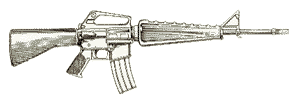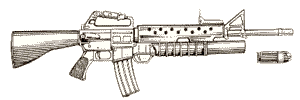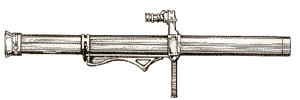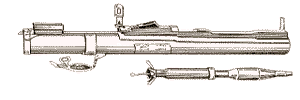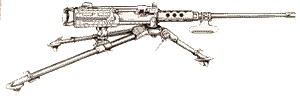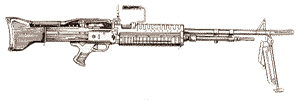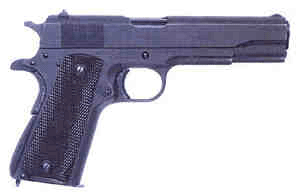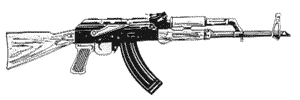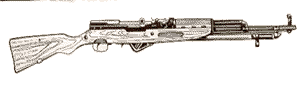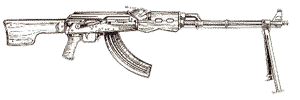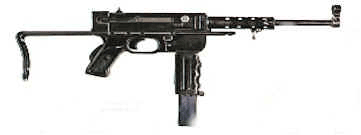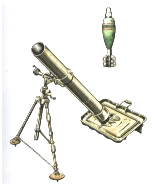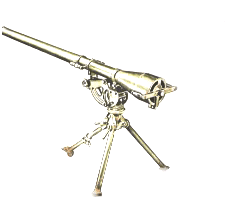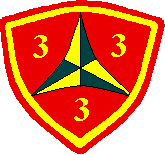

M-14 RifleThe M-14 saw service in Vietnam from 1957 onwards until its replacement. The M14 national Match (Accursed) was the sniper rifle variant, later renamed the M-21.Production of the M14 ceased in 1964 but a further variant was the M14A1 which came close to being a light machine-gun. The M14A1 had a pistol grip, a folding fore-hand grip about half-way down the forestock, a folding bipod, a shoulder strap, and a sleeve was fitted over the muzzle to act as a compensator when firing fully automatic. This helped to keep the barrel down and prevent climb. The M-14 was adopted in 1957 as the successor to the WWII M-1 Garand, and was basically an evolution of that rifle. The main and more obvious improvements were the gas system and magazines. On the M-1 the magazine was fixed and had to be loaded using a charger. On the M-14, detachable 20-round box magazines were used. The normal M-14 fired semi-automatic only. A slide-on bipod could be provided, and the rifle fitted the M-76 grenade launcher which was slipped on to the flash suppressor and secured to the bayonet lug. The M-14 weighed 5.1-kg (11.22 pounds) with a full magazine and cleaning kit carried. It had a maximum effective range on semi-automatic without the M-2 bipod of 460-meters. When the bipod was added this range increased to 700-meters. A special suppressor was fitted to the muzzle of the sniper rifle which did not affect the performance of the bullet, but reduced the velocity of the emerging gases to below that of sound. This made location very difficult as the target heard only the crack of the bullet and no shot from the rifle.
M-16 Rifle
This is the weapon most
commonly associated with US troops in Vietnam. Despite early problems with the
weapon it has now become a respected assault weapon. The 5.56mm M16A1 is a gas
operated magazine-fed rifle capable of semi-automatic and automatic fire with
an effective range of 300 meters and a practical rate of fire of 60 rpm.
M-203 Grenade Launcher
The combination M16A1
automatic rifle and M203 (a version of the M79) grenade launcher was produced
to avoid the problem of a Grenadier having to carry a grenade launcher as well
as a weapon for personal protection and hence allowing him to also function as
a rifleman. The 40mm grenade launcher was used to provide additional fire support for the infantry by delivering high explosive, parachute flares and canister rounds. The high explosive had a maximum range of 400 meters and a casualty radius of 5 meters.
M-67 Recoilless Rifle
Measuring 1,346-mm
(53-inches) in length and weighing in at a hefty 16-kg (35-lbs), the M-67 was
intended for use against AFV's and bunkers as a portable crew served weapon. It
was a breech-loaded, single-shot weapon which was shaped like a long tube with
the sight assembly and firing mechanism offset to the side in opposite
directions about half way along the barrel. The breech was hinged on the right
side, and had to be swung open to load the round. It was then swung closed and
when the rifle was fired, the rear end of the shell case broke up and was blown
out of the back of the breech block. Capable of maintaining a sustained fire rate of 1 round per minute, the weapon could be fired at an increased rate of 1 round every 6 seconds (10 rpm) by a well trained crew. However, due to excessive heating at this rate of fire, it was necessary to allow the weapon a 15-minute cooling period after each 5 rounds fired. The maximum range of the M-67 was 400-meters (437-yds) and was sighted to 800-meters (875-yds) although the shell could actually be fired out to 2,000-meters (2,187-yds). Requiring a crew of three (gunner, assistant gunner and ammo bearer) the M-67 fired a 9.5-lb M371E1 HEAT round and could be shoulder fired or ground mounted.
M-1/M-2 Carbine Rifle
The M1 Garand was the
weapon of choice for infantry. The M1 Carbine, half the weight and with a less
powerful cartridge, was the weapon of choice for support troops, and others not
primarily involved in infantry combat. It was designed to meet combat needs
less demanding than the M1 Rifle, but more than can be met by the M1911A1
pistol. It was more convenient to use than the M1, and less intrusive to their
other duties, while still much more effective than hand guns.Originally, the M1 was to be capable of selective fire control, but this was dropped. Because a demand arose for an automatic capability, the M2 was developed, with a selective-fire switch added to the left side of the receiver, operating on the sear mechanism. The US Carbine, Caliber .30in, M3, or T3, was simply an M2 with suitable mountings prepared on the receiver to take various models of infra-red night-sighting devices. No open or conventional sights were provided, and the IR carbine mounted an M3 flash hider, a simpler design than that for the M1C Garand. The M3 carbine, (its development title was T3), was produced in limited numbers as a semi-prototype. Only about 2100 were manufactured compared to 5,510,000 M1 carbines, 150,000 M1A1 carbines and 570,000 M2 carbines. The M1 and M2 Carbines were also much more powerful than the Russian type burp guns used by the North Koreans and, later, the Chinese, having more than twice their muzzle energy. In the infantry, the M2 Carbine was carried by Staff NCOs and officers. With its 30 round magazine, rapid fire and greater stopping power, it was an effective counter to the various submachine guns used by the Communists in the Korean War. In intense cold, however, such as the Chosin battle, light weapons such as the carbine and air-cooled .30 calibre light machine guns malfunctioned much more often than the M1 and the water-cooled heavies, with anti-freeze in their jackets. The Marines used alcohol based hair tonic as anti-freeze lubricants for all light weapons, with good success, but the carbine components were small and fragile, and repeatedly malfunctioned. The Carbine continued to be used in Viet Nam, until replaced by the M16.
M-72 Light Anti-tank Weapon
Weighing 2.37-kg (5.2
pounds) complete, the LAW was designed as a discardable one-man rocket launcher
primarily for use as an anti-tank weapon. In Vietnam however, the LAW was used
almost exclusively as a bunker buster or for attacking entrenched enemies.When carried, the smooth-bore launcher tube was carried closed, and was watertight. In action, the end covers were opened by removing safety pins and the inner tube was telescoped outwards. This cocked the firing mechanism. Held over the shoulder, aimed by the simple sights, the weapon was fired by pressing the trigger button. The LAW Fired a 1-kg rocket to a maximum effective range of 300m. The rocket motor was fully burnt out by the time it left the launcher and resulted in a large back-blast danger area behind the firer. Once fired the tube was discarded. Due to it's low weight, a number of complete assemblies could be carried in a squad with each person capable of packing at least two if necessary.
M-79 Grenade Launcher
Commonly known as the
'Thumper' or 'Blooper', this weapon first appeared during the Vietnam war and
closely resembled a large bore, single barrel, sawn-off shotgun. The first M79
Grenade launchers were delivered to the US Army in 1961.The M79 was designed as a close support weapon for the infantry, with two weapons being issued to each rifle squad. The tactical use of the weapon required the gunner (grenadier) to be dedicated to the weapon and only carried a pistol as a side arm. the M79 was intended to bridge the gap between the maximum throwing distance of a hand grenade, and the lowest range of supporting mortar fire - between 50 and 300 meters - and thus gave the squad an integral indirect fire weapon. With a length of 737mm (barrel = 355mm) and a loaded weight of 3kg, (6 and a half pounds) the M79 was an ideal weapon in the close terrain of Vietnam. The M79 was a single shot, shoulder fired, break-barrel weapon which fired a spherical 40mm diameter grenade loaded directly into the breech. It had a rubber pad fitted to the shoulder stock to absorb some of the shock. The M-406 40mm HE grenades fired from the M79 traveled at a muzzle velocity of 75 meters per second, and contained enough explosive within a steel casing that upon impact with the target would produce over 300 fragments at 1,524 meters per second within a lethal radius of up to 5 meters. Stabilized in flight by the spin imparted on it by the rifled barrel the grenade rotated at 3,700rpm, this in turn, after approximately 15 meters of flight, armed the grenade. For close range fighting the Army came up with two types of M79 rounds. The first was a flechette round ( or Bee Hives round) which housed approx 45 small darts in a plastic casing, these rounds were issued on an experimental basis. Later this round was replaced by the M-576 buckshot round. This round contained twenty-seven 00 buckshot which on firing was carried down the barrel in a 40mm plastic sabot which slowed down in flight so that the pellets could travel in their forward direction un-aided. The M79 could also fire smoke grenades (both standard and parachute), CS gas, and flares. The M79 had a large flip up sight situated half way down the barrel, with a basic leaf foresight fixed at the end of the barrel. The rear sight was calibrated up to 375 meters (410 yds) in 25 meter (27.3 yds) intervals. In the hands of a good experienced Grenadier the M79 was highly accurate up to 200 meters. Later in the war the M79 was superseded by the M203.
Browning .50 Cal Machine Gun
The Browning M2 .50
caliber (12.7mm) Machine Gun, is a World War II era automatic, belt-fed, recoil
operated, air-cooled, crew-operated machine gun. The M2 is crew transportable
with limited amounts of ammunition over short distances. This gun is has a back
plate with spade grips, trigger, and bolt latch release. The gun is equipped
with leaf-type rear sight, flash suppressor and a spare barrel assembly. By
repositioning some of the component parts, ammunition may be fed from either
the left or right side. A disintegrating metallic link-belt is used to feed the
ammunition into the weapon. The gun is capable of single-shot (ground M2), as
well as automatic fire.This gun may be mounted on ground mounts and most vehicles as an anti-personnel and anti-aircraft weapon. Associated components are the M63 antiaircraft mount and the M3 tripod mount. The M2 .50 Cal. flexible version is used as a ground gun on the M3 tripod mount or various Naval mounts. The M2 .50 Cal., M48 turret type, fixed type, and soft mount are installed on mounts of several different types of combat vehicles and ships. The weapon provides automatic weapon suppressive fire for offensive and defensive purposes. This weapon can be used effectively against personnel, light armored vehicles; low, slow flying aircraft; and small boats. The M2 machine gun on the M3 tripod provided a very stable firing platform. Together with its slow rate of fire and its traversing and elevating mechanism, the M2 was used to a very limited extent as a sniper weapon during the Vietnam war at fixed installations such as firebases. Snipers prefired the weapons at identifiable targets and worked the data into range cards insuring increased first-round accuracy. The 1st Battalion, 5th Infantry, 25th Infantry Division constructed 20-30 foot high shooting platforms, adding steel base plates and posts to further stabilize the M2 on the M3 tripod. Together with the use of Starlight night vision scopes, the M2 severely limited enemy movement within 900 yards (1,000m) of the perimeter of a firebase.
M-60 Machine Gun
The 7.62mm M60 general
purpose machine-gun (GPMG) was employed in a light role on it's bipod
(effective range 500 meters) or in a medium role on a tripod (effective range
1,100 meters) as well as being used as protective armament on vehicles and
helicopters. Gas operated, air cooled and belt fed, with a quick-change barrel to counter overheating during sustained firing, it has a practical rate of fire of 200 rpm (550 rpm max). In Vietnam it was the main firepower of the infantry rifle section. With bipod the M60 weighs 10.5 kg (23 pounds), which increases by 6.8kg (15 pounds) if a tripod is added (Total 38 pounds minus ammo).
M-1911 Handgun
The M-1911 Handgun is a
.45 Automatic Pistol. After the end of the Second World War the military was
awash in .45 pistols, and many were given away as part of foreign-aid packages
to other countries. Still others were sold through the Director of Civilian
Marksmanship in the 1950's to civilians wishing to participate in Service
Pistol Matches being held across the country. And yet more were smuggled back
home inside duffel bags, though not nearly as many since the government was
wise to it this time around. The remaining pistols stayed on active duty throughout the next several decades, being used in Korea, Vietnam, and countless other Cold-War military involvements. Once again during the war in Korea many a soldier had to fall back on his .45 when his primary weapon froze in the extreme cold of the Korean winter. During Vietnam it was the weapon to use while crawling through Viet Cong underground caves, a .45 in one hand and a flashlight in the other. Throughout all this time the M1911A1s did their part well, but as time went on many more were lost due to combat or attrition and the survivors began to show their age. Large numbers of .45s had to be sent in to be rebuilt at military arsenals (the average pistol was rebuilt twice in its service life), and many of those became mismatched when large numbers were disassembled at once, rebuilt, then put back together from the pile of parts. For example a Colt slide would be placed on an Ithaca frame, the remaining parts fished out of the pile to build a complete pistol, and in the end there would be a pile of parts left from guns that couldn't be fitted back together properly. By the late 1970's the military's supply of serviceable .45 handguns had been pared down significantly, as no new ones had been purchased since 1945 and attrition was taking its toll. In addition there were scores of .38 and .45 revolvers of countless variations being used by the Air Force and other units, adding to the problem of logistics.
AK-47 Assault Rifle
Easily recognized with
its high front sights, large selector/safety switch on the right side and the
long, curved banana magazine, this is the Soviet version with a conventional
wooden buttstock. The AK-47 is a gas-operated, magazine-fed rifle which has a
semiautomatic ROF of 40 rounds (effective range about 400 meters), increasing
to 100 rounds on fully automatic (effective range about 300 meters). It has a
30 round detachable box magazine. Renowned for it's durability, the AK-47 is
shorter and heavier than the M-16 but with a lower ROF and muzzle velocity.
Simonov SKS Rifle
A 7.62mm semi-automatic
carbine with an effective range of 400 meters, the SKS has a 10 round integral
magazine and an ROF of 30-35 rounds per minute. The SKS resembles a
conventional bolt action rifle but is equipped with an integral folding bayonet
under the muzzle. Used extensively by the Vietcong, it weighed 3.86kg, had a length of 1020mm and a muzzle velocity of 735m per second.
RPD Machine Gun
The standard infantry
squad support weapon, the RPD was analogous to the US M-60 and fired a 7.62mm
slug from a 100 round belt which was usually contained in a drum mounted below
the gun. The drum itself could be changed in a matter of seconds by an experienced gunner and protected the ammo from dirt and hence jamming. With a maximum rate of cyclic fire of about 150 rounds per minute, an effective range of 800m and rapid reload time, this light and uncomplicated weapon was capable of laying down sustained heavy fire. The gunner was usually accompanied by an assistant acting as an ammo carrier, loader and capable of taking over as the primary gunner in the event of the main gunner becoming a casualty. The RPD was approximately 1036mm in length (521mm barrel ) and had a muzzle velocity of 700m per second.
MAT-49 Sub Machine Gun
Produced by the
Manufacture díArmes de Tulle (MAT) in 1946 and using the 9mm Parabellum
cartridge this SMG was adopted by the French Army in 1949 (hence the
designation MAT49). The weapon was widely used by French forces in Indo-China
and many found their way into the hands of the Vietminh and eventually the Viet
Cong.The Vietnamese modified the weapon to fire the Soviet 7.62mm x 25P ammunition and itís PRC equivalent by fitting a longer 7.62mm barrel. However, they did keep all the essential features of the MAT49 except for replacing the 32-round box with a 35-round magazine. One of the remarkable features of the weapon was the sliding wire butt stock which could be pushed forward out of the way for carrying and pulled to the rear if it was to be used in firing. The magazine housing on the receiver could be rotated forward through 90-degrees (even with the magazine fitted) to lie along the barrel. These features made the MAT49 particularly suitable for troops who required compactness in carriage. At the back part of the pistol grip was a grip safety, which was operated by the action of squeezing the pistol grip when firing a round. This released the safety catch. When the grip safety was not squeezed, it locked the bolt in the forward position, and locked the trigger when the weapon was cocked. The lock was released by the pressure of the palm of the hand. The weapon could not be accidentally discharged.
RPG-7 Rocket Launcher
The RPG-7 (CHICOM
Type-69) is a muzzle loaded, shoulder fired antitank grenade launcher. The VC
and NVA used the RPG7V, a Soviet produced short-range, anti-Armour,
rocket-propelled grenade, from 1967 against armored vehicles, defensive
positions, personnel and even helicopters. This smoothbore, recoilless weapon consists of a launcher tube fitted with a simple iron sight or a more sophisticated telescopic range-finding sight, and a HEAT rocket grenade projectile with a caliber of 40mm. The RPG-7 has an effective range of 300 meters against moving targets and up to 500 meters against stationary targets. The projectile explodes
either on impact or at its maximum range of 920 meters.
81 mm Mortar
The 81mm Mortar was
manufactured in North Vietnam and is a copy of the US 81 mm MI Mortar. Very
popular with the Vietcong as it could be broken down into three one-man loads.
75 mm Recoilless Rifle
The 75 mm recoilless
rifle was very popular with Vietcong forces because of the combined firepower
and light weight. A direct copy of the obsolete US M-20 - it was quite adequate
for the needs of the Vietcong.
Tokarev Handgun
First introduced in the
1930ís and utilizing the self-cocking design from Colt, the Tokarev TT33 was
used extensively by Soviet forces in WWII and was produced in nearly all Warsaw
Pact countries and the PRC.The Chinese Type-54 could be distinguished from the Soviet TT33 by the serrations on the slide and by the Chinese ideograms on the pistol grip (the Soviet weapon had a star in the center of the pistol grip). The Soviet TT33 had alternate narrow and wide vertical cuts, whereas the Type-51 and Type-54 had uniform narrow markings, to aid gripping the slide when manually cocking the weapon. There was no safety mechanism but the hammer could be locked at half-cock and the weapon was normally carried around with a round in the chamber. Production of the weapon in the USSR stopped in 1954, but continued in other Communist countries, notably the PRC. The pistol was widely used by VC and NVA officers. The Tokarev TT33 fired the Soviet 7.62-mm x 25 Type-P pistol cartridge. It operated on a recoil single action and was semi-automatic, feeding ammunition from an 8-round box magazine. Maximum ROF was 32-rpm and with a maximum effective range out to about 50-meters. The pistol was quite heavy, weighing about 1-kg (2.2-lbs) when loaded and was 196-mm (7.72-inches) in length.
 M-14  M1 Carbine  AR-15 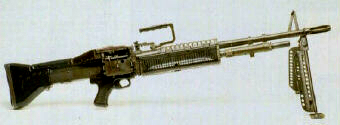 M60 Machine gun  Law  81mm Mortor 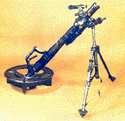 60mm Mortor  38 Cal 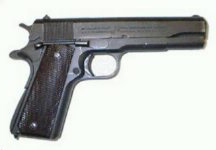 45 Cal 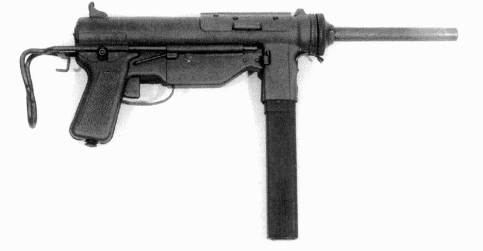 M3A1 Submachine gun 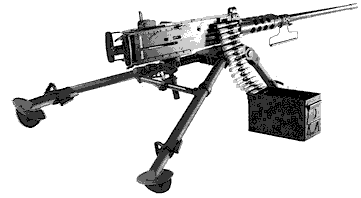 50 Cal 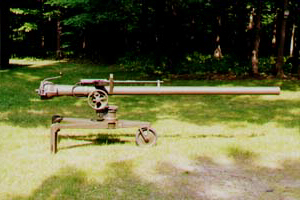 106 recoilless Rifle 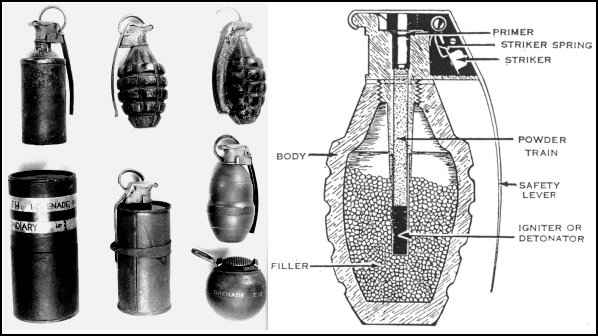 Grenades  AK47 M60 General Purpose Machine Gun Features: The M-60 series general purpose machine gun is a light weight, belt fed, gas operated, air cooled weapon with fixed headspace and timing to allow for the rapid exchange of barrels during sustained firing situations. The M-60 can be carried and operated by one individual, though it is common practice to assign the weapon to a fire team (gunner and assistant gunner, who carries an additional barrel and ammunition.) The M-60 is equipped with an integral bipod assembly which can be used to stabilize the weapon during offensive operations. Optionally, the M-60 can be set up on a tripod for increased stability and long range accuracy. In addition to the basic M-60 there are 2 variant models; the M-60 C/D (for use on helicopters) and the M-60E3, a lighter version of the basic model used by the Marine Corps and U.S. Special Operations Forces. Length: 42.4 inches (107.70 centimeters) Weight: 18.75 pounds (8.51 kilograms) Bore diameter: 7.62mm (.308 inches) Maximum effective range: 3609.1 feet (1100 meters) Maximum range: 2.3 miles (3725 meters) Muzzle velocity: 2800 feet (853 meters) per second Rates of fire: Cyclic: 550 rounds per minute Rapid: 100 rounds per minute* Sustained: 100 rounds per minute* (* with barrel changes at each 100 rounds) Unit Replacement Cost: $6,000 M19 60mm Mortar One of the most common field support weapons, this portable mortar fired as many as 30 rounds of high-explosive, smoke, or illumination rounds per minute. It had an effective range of approximately 45- 2000 yards. The M19 could be operated from a hand-held position or mounted on the ground using a steel base plate. 105mm Howitzer A favored support gun, the 105 mm howitzers first used in Vietnam had seen action in World War II. Modified to improve field mobility, the guns served admirably throughout the Vietnam conflict. An 8-man crew operated the 105, which could be towed behind a 6x6 truck or carried into position by helicopter. The weapon fired about 3-8 rounds per minute, and handled a variety of ammunition, including high explosive shrapnel shells and "beehive" cartridges, which contained thousands of small, sharpened darts. The 105 had a range of about 12,500 yards. Mark 2 anti-personnel hand-rifle grenade Soldiers often carried fragmentation grenades, which could be thrown about 30 yards, or propelled accurately at distances of about 150 yards using a rifle-mounted launcher. Carrying grenades through thick jungle was a hazardous proposition. Fuse pins sometimes could catch on undergrowth and pull from grenades, resulting in unintentional and deadly explosions. M18A1 Claymore antipersonnel mine Soldiers frequently used these portable tripod-mounted mines to form a perimeter around a night encampment. When triggered by a tripwire or a manually-operated lanyard, the mine released a charge of 700 steel balls in a 60 degree arc, with an effective range of about 50 yards.
M1911A1 .45 Caliber Pistol
The M1911A1 .45 cal. pistol was the standard personal defense weapon carried by officers of all
services during World War I, World Was II, Korea and Vietnam. It has a rich military heritage, was very
reliable, and the weapon of choice for use in close quarters.
The pistol is a recoil-operated hand weapon. It is a magazine-fed
semiautomatic weapon, which fires one round each time the trigger is squeezed once the hammer is
cocked by prior action of the slide or thumb. This design is referred to as "single action only."
The thumb safety may only be activated once the pistol is cocked. The hammer remains in the fully
cocked position once the safety is activated. (Note: More modern pistol designs of the "double action"
type will allow the hammer to move forward to an uncocked position when the thumb safety is activated.)
The M1911A1 was widely respected for its reliability and lethality. However, its single action/cocked
and locked design required the user to be very familiar and well-trained to allow carrying the pistol
in the "ready-to-fire" mode. Consequently, M1911A1s were often prescribed to be carried without a round
in the chamber. Even with this restriction on the user, numerous unintentional discharges were documented yearly.
Although commercial pistols were purchased and issued to General Officers, some standard Army issue
pistols were specially modified for use by General Officers, including the Pistol, Cal. .45, Semi-automatic,
M1911A1, General Officer's. Additional Information |

